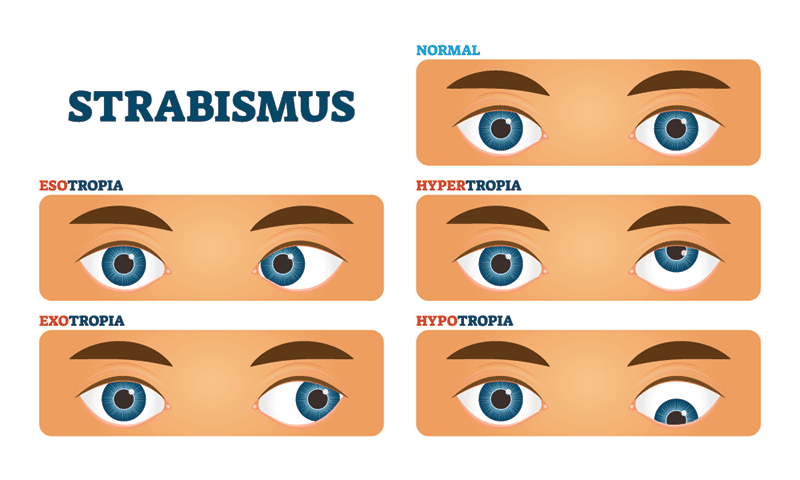Strabismus is the term for misalignment of the eyes. Normally the two eyes are pointed in the same direction. In strabismus, one eye looks straight ahead while the other may point inward, outward, up or down. Strabismus affects approximately 4% of all children in the United States. It can run in families but many children with strabismus have no relative with this disease.

With normal alignment of the eyes, the brain receives a similar picture from each eye. The brain then “overlaps” or fuses these two pictures into one image. This allows the brain to see in three dimensions, which provides depth perception. In strabismus, two different pictures are sent to the brain. Since the brain cannot fuse dissimilar images, this situation can result in the perception of double vision.
In children, double vision is fairly uncommon because their brains can ignore or suppress the second image coming from the deviated eye. Adults who develop strabismus, on the other hand, frequently will report double vision.
When strabismus is present, depth perception is lost. Additionally, in children, permanently reduced vision or amblyopia can result in the deviated eye from lack of use if treatments, such as patching, glasses and/or surgery, are not instituted early enough.
Signs of strabismus may include a noticeable deviation of one eye, abnormal head posture, closing of one eye, rubbing of the eyes or, rarely, headaches.
The cause of strabismus is not fully understood in all cases. Each eye is controlled by six eye muscles that allow for horizontal, vertical and diagonal movements of the eye. Specific eye muscles from each eye work together, moving the two eyes in unison.
Keeping the eyes straight requires eye muscle coordination which is controlled by the brain. Thus, damage to the nervous system from conditions such as a stroke, head trauma, tumor or cerebral palsy can cause strabismus. Damage to eye muscles themselves, from Graves’ eye disease or orbital bone fractures, can cause strabismus.
Adults usually develop strabismus from nervous system or eye muscle damage unless they have residual strabismus from childhood. Children, on the other hand, develop strabismus for reasons that are less well understood. It most likely results from a congenital instability of fusion in the brain.
It is important for a child to have a full ophthalmological evaluation if strabismus is suspected. Usually an ocular misalignment is first noticed by the parents or primary care physician. It is not a good idea to wait to see if a child will “outgrow” a strabismus since this is extremely rare. Treatment of strabismus and/or amblyopia with glasses, patching and/or surgery is most successful if instituted early.
Children should have an eye evaluation, including a vision check, by either their primary care physician, a vision screening program or an ophthalmologist by the age of three. If there is a family history of strabismus or amblyopia, then an ophthalmologist should perform an examination as early as age one to two years.
Infants frequently have the appearance of crossed-eyes because of the excess skin on the bridge of their nose (epicanthal folds). This should at least be evaluated by the primary care physician and if there is any question as to the presence of a true strabismus, then an ophthalmologist should examine the child.
The goals for treating strabismus are four-fold:
Treating strabismus results in improved appearance, which is important, since studies show that people with uncorrected strabismus have lower self-esteem and more difficulty obtaining employment. Realignment of the eyes is not a cosmetic procedure; it is a reconstructive procedure.
Strabismus may require eye muscle surgery to correct a misalignment of the eyes. In general, eye muscle surgery is safe and effective for both children and adults.
Not every misalignment of the eyes requires strabismus surgery to improve or correct it. Sometimes eye muscle exercises (orthoptic therapy) or eyeglasses with or without prisms can improve a strabismus without having to resort to surgery.
Wheaton Eye Clinic’s unparalleled commitment to excellence is evident in our continued growth. Today we provide world-class medical and surgical care to patients in six suburban locations—Wheaton, Naperville, Hinsdale, Plainfield, St. Charles, and Bartlett.
(630) 668-8250 (800) 637-1054